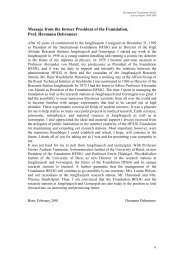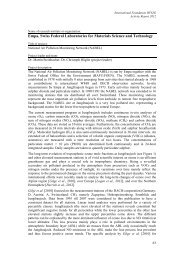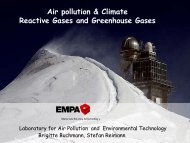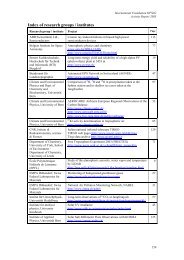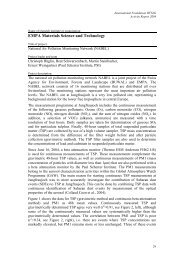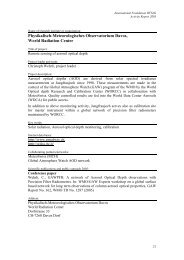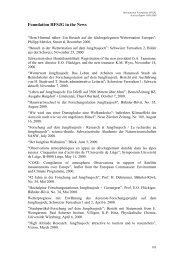- Page 1 and 2: International Foundation High Altit
- Page 3 and 4: International Foundation HFSJG Annu
- Page 5 and 6: International Foundation HFSJG Annu
- Page 7 and 8: International Foundation HFSJG Acti
- Page 9 and 10: International Foundation HFSJG Acti
- Page 11 and 12: 25 20 15 23 International Foundatio
- Page 13 and 14: International Foundation HFSJG Acti
- Page 15 and 16: International Foundation HFSJG Acti
- Page 17 and 18: International Foundation HFSJG Acti
- Page 19 and 20: International Foundation HFSJG Acti
- Page 21 and 22: International Foundation HFSJG Acti
- Page 23 and 24: Long-term experiments and automatic
- Page 25 and 26: International Foundation HFSJG Acti
- Page 27 and 28: International Foundation HFSJG Acti
- Page 29 and 30: International Foundation HFSJG Acti
- Page 31 and 32: International Foundation HFSJG Acti
- Page 33 and 34: International Foundation HFSJG Acti
- Page 35 and 36: International Foundation HFSJG Acti
- Page 37 and 38: International Foundation HFSJG Acti
- Page 39 and 40: International Foundation HFSJG Acti
- Page 41 and 42: International Foundation HFSJG Acti
- Page 43 and 44: International Foundation HFSJG Acti
- Page 45: International Foundation HFSJG Acti
- Page 49 and 50: International Foundation HFSJG Acti
- Page 51 and 52: International Foundation HFSJG Acti
- Page 53 and 54: International Foundation HFSJG Acti
- Page 55 and 56: International Foundation HFSJG Acti
- Page 57 and 58: International Foundation HFSJG Acti
- Page 59 and 60: International Foundation HFSJG Acti
- Page 61 and 62: International Foundation HFSJG Acti
- Page 63 and 64: Graph 2 shows the calculated net be
- Page 65 and 66: International Foundation HFSJG Acti
- Page 67 and 68: International Foundation HFSJG Acti
- Page 69 and 70: International Foundation HFSJG Acti
- Page 71 and 72: International Foundation HFSJG Acti
- Page 73 and 74: International Foundation HFSJG Acti
- Page 75 and 76: International Foundation HFSJG Acti
- Page 77 and 78: International Foundation HFSJG Acti
- Page 79 and 80: International Foundation HFSJG Acti
- Page 81 and 82: International Foundation HFSJG Acti
- Page 83 and 84: International Foundation HFSJG Acti
- Page 85 and 86: International Foundation HFSJG Acti
- Page 87 and 88: International Foundation HFSJG Acti
- Page 89 and 90: International Foundation HFSJG Acti
- Page 91 and 92: International Foundation HFSJG Acti
- Page 93 and 94: International Foundation HFSJG Acti
- Page 95 and 96: International Foundation HFSJG Acti
- Page 97 and 98:
International Foundation HFSJG Acti
- Page 99 and 100:
International Foundation HFSJG Acti
- Page 101 and 102:
International Foundation HFSJG Acti
- Page 103 and 104:
International Foundation HFSJG Acti
- Page 105 and 106:
International Foundation HFSJG Acti
- Page 107 and 108:
International Foundation HFSJG Acti
- Page 109 and 110:
International Foundation HFSJG Acti
- Page 111 and 112:
International Foundation HFSJG Acti
- Page 113 and 114:
International Foundation HFSJG Acti
- Page 115 and 116:
Collaborating partners/networks: Un
- Page 117 and 118:
International Foundation HFSJG Acti
- Page 119 and 120:
Address: School of Earth, Atmospher
- Page 121 and 122:
International Foundation HFSJG Acti
- Page 123 and 124:
International Foundation HFSJG Acti
- Page 125 and 126:
International Foundation HFSJG Acti
- Page 127 and 128:
International Foundation HFSJG Acti
- Page 129 and 130:
International Foundation HFSJG Acti
- Page 131 and 132:
International Foundation HFSJG Acti
- Page 133 and 134:
International Foundation HFSJG Acti
- Page 135 and 136:
International Foundation HFSJG Acti
- Page 137 and 138:
International Foundation HFSJG Acti
- Page 139 and 140:
International Foundation HFSJG Acti
- Page 141 and 142:
International Foundation HFSJG Acti
- Page 143 and 144:
International Foundation HFSJG Acti
- Page 145 and 146:
International Foundation HFSJG Acti
- Page 147 and 148:
International Foundation HFSJG Acti
- Page 149 and 150:
International Foundation HFSJG Acti
- Page 151 and 152:
International Foundation HFSJG Acti
- Page 153 and 154:
International Foundation HFSJG Acti
- Page 155 and 156:
International Foundation HFSJG Acti
- Page 157 and 158:
International Foundation HFSJG Acti
- Page 159 and 160:
International Foundation HFSJG Acti
- Page 161 and 162:
International Foundation HFSJG Acti
- Page 163 and 164:
Key words UV, erythemal irradiance,
- Page 165 and 166:
International Foundation HFSJG Acti
- Page 167 and 168:
International Foundation HFSJG Acti
- Page 169 and 170:
International Foundation HFSJG Acti
- Page 171 and 172:
International Foundation HFSJG Acti
- Page 173 and 174:
International Foundation HFSJG Acti
- Page 175 and 176:
International Foundation HFSJG Acti
- Page 177 and 178:
International Foundation HFSJG Acti
- Page 179 and 180:
International Foundation HFSJG Acti
- Page 181 and 182:
International Foundation HFSJG Acti
- Page 183 and 184:
International Foundation HFSJG Acti
- Page 185 and 186:
International Foundation HFSJG Acti
- Page 187 and 188:
International Foundation HFSJG Acti
- Page 189 and 190:
International Foundation HFSJG Acti
- Page 191 and 192:
International Foundation HFSJG Acti
- Page 193 and 194:
International Foundation HFSJG Acti
- Page 195 and 196:
International Foundation HFSJG Acti
- Page 197 and 198:
International Foundation HFSJG Acti
- Page 199 and 200:
International Foundation HFSJG Acti
- Page 201 and 202:
International Foundation HFSJG Acti
- Page 203 and 204:
International Foundation HFSJG Acti
- Page 205 and 206:
International Foundation HFSJG Acti
- Page 207 and 208:
International Foundation HFSJG Acti
- Page 209 and 210:
International Foundation HFSJG Acti
- Page 211 and 212:
The International Foundation HFSJG
- Page 213 and 214:
International Foundation HFSJG Acti
- Page 215 and 216:
International Foundation HFSJG Acti
- Page 217 and 218:
International Foundation HFSJG Acti
- Page 219 and 220:
International Foundation HFSJG Acti
- Page 221 and 222:
International Foundation HFSJG Acti
- Page 223 and 224:
International Foundation HFSJG Acti
- Page 225 and 226:
International Foundation HFSJG Acti
- Page 227 and 228:
Index of research groups / institut
- Page 229 and 230:
International Foundation HFSJG Acti
- Page 231 and 232:
International Foundation HFSJG Acti
- Page 233 and 234:
International Foundation HFSJG Acti
- Page 235 and 236:
Picture Gallery 2005 from http://ww
- Page 237 and 238:
International Foundation HFSJG Acti
- Page 239 and 240:
International Foundation HFSJG Acti
- Page 241 and 242:
International Foundation HFSJG Acti
- Page 243 and 244:
International Foundation HFSJG Acti
- Page 245 and 246:
International Foundation HFSJG Acti
- Page 247 and 248:
International Foundation HFSJG Acti
- Page 249:
International Foundation HFSJG Acti



